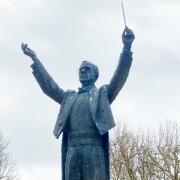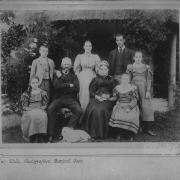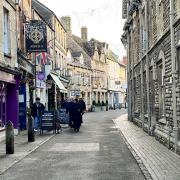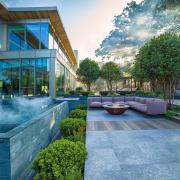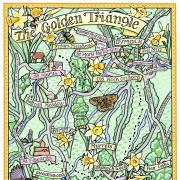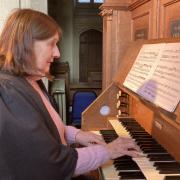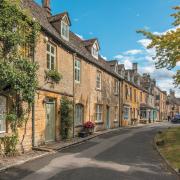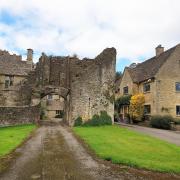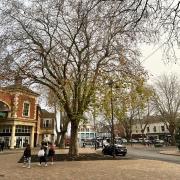Kirsty Hartsiotis takes us on a whistle-stop tour of Cotswold stained-glass windows
When I first started looking at churches when I was a student, I was obsessed with stone. I didn’t really see stained glass, only noticing it except in a few exceptional places, like Chartres cathedral. It wasn’t until the last few years that I really started looking, drawn by my fascination for all things Arts and Crafts Movement – but now I’m hooked. There’s a lot of it about, mostly Victorian, but this will be a whistle-stop circular (almost!) tour of 700 years of stained glass in Gloucestershire. Gloucestershire’s churches contain some remarkable stained glass from all periods – this is just a taster!

Bibury
If you head into the chancel, you’ll find the very earliest stained glass in Gloucestershire. It’s not that impressive – but it dates from the 13th century. It’s just a ‘lancet’, a single, pointed window, and has a simple pattern in what’s called ‘grisaille’. It’s mainly clear glass with a pattern picked out in the leading and painted with the then fashionable stiff leaves, with just pops of blue and flashed red glass. It was probably designed and made here in Gloucestershire, by a British person. At that time, that was by no means common. Coloured glass was brought in from as far away as Syria, but was mostly made in France. If you look across the chancel there is a very large lancet containing a beautiful panel by an Arts and Crafts designer, Karl Parsons, from 1926. The vivid blue and the Madonna and both recall the 13th century glass from Chartres in France, that, with the slightly earlier St. Denis in Paris, caused the revolution in stained glass in the 12th and 13th centuries that filled Christian churches full of coloured glass.
St. Mary, Bibury – open every day

Fairford
The very late medieval scheme of glass at Fairford is one of the most important schemes of medieval glass in the country. There is nothing like this in any other parish church in the UK. Most medieval glass was destroyed in either the Reformation in the 16th century or by Puritan zeal in the 17th, but Fairford survives – perhaps taken out and hidden, perhaps an agreement made not to destroy it. By this time, both clergy and richer members of the congregation were allowed into the sacred, eastern part of the church, so more people could see the sacred stories in the glass. As all of this was commissioned by the local landowner, Sir Edward Tame, that would have been important!

We can all see what they saw now, the story of Mary and Christ, from the Fall of Adam and Eve through to the Assumption of the Virgin, in naturalistic scenes populated with a cast of thousands. It’s like looking at a series of early Renaissance paintings, not the medieval stained glass we think we know. Saints, prophets. rogues, angels and demons parade through the windows of the nave, all in glorious technicolour. Fairford shows us the rich world of religion at the end of the Middle Ages – what came next was destruction and austerity. Out went smells, bells and creating beauty for God and in came fire and brimstone sermons. From the 16th to the 19th century there was very little stained glass made in Britain.
St. Mary, Fairford – open every day

Tetbury
At the beginning of Queen Victoria’s reign everything changed. The gothic was fashionable once more, as was church building and beautifying! A remarkably intact early Victorian example of the kind of church that was popular in the 1840s can be found at St Saviour’s in Tetbury, the church designed by prolific Gloucester architect Samuel Daukes, with glass by Bristol-based Michael O‘Connor, whose claim to fame was that he worked with A W N Pugin, who was one of those architects who had popularised the gothic style once more and is best known for his decoration of the Houses of Parliament. This little church in Tetbury was built as a ‘little church for the poor’. Most people had to pay to go to the main church in the town, which, unsurprisingly, was putting people off attending! The church is inspired by the Decorated style of the 14th century, and is very high church – for better or for worse, dark, incense-filled churches rich with stained glass were back.
St. Saviour, Tetbury, opened by the Churches Conservation Trust, 10-4 Monday-Saturday

Selsley
By the middle of the 19th century, something new happened. Previously, Victorian stained glass designers were architects or craftspeople: now artists got in on the act. Young designer William Morris, along with his friends’ artists Dante Gabriel Rossetti, Edward Burne-Jones and Ford Madox Brown, and architect Philip Webb, set up a company to produce artistic interior decoration – including stained glass. All Saints, Selsley, designed by their friend G F Bodley, was their first major commission in 1862.

Inspired by the glazing scheme in Merton College Chapel, Oxford, they created something new, with naturalistic, Pre-Raphaelite scenes featuring friends and family as models. Morris and Co., as it would come to be known, would revolutionise interior design in both houses and churches, and Edward Burne-Jones would become the most influential stained-glass designer of the century. This is a chance to see their work in its infancy.
All Saints, Selsley, open all day

Gloucester cathedral
It’s no surprise that there’s a feast of glass from all periods in the county’s cathedral. The 14th-century Great East Window is a masterpiece of glazing and lace-like tracery alike. There’s also exciting contemporary glass by Tom Denny. But the crowning glory of Gloucester’s glass is the Arts and Crafts glass in the Lady Chapel by Christopher Whall. Whall was not just a designer, he cut and painted and leaded his own glass in true Arts and Crafts fashion. After some debate in the Cathedral Chapter about whether such an avant garde artist should be used, the glass began to be installed in 1899. The last panels were still being added by his daughter Veronica after Whall’s death in the mid-1920s. It’s inspired by Burne-Jones and the Pre-Raphaelites, but with far greater variety of texture and depth of feeling. Saints soar, inspired by the red, blue and white East Window, against complex white backgrounds – but do have a look at the small panels at the bottom telling the stories of the saints with rich historical and natural detail – there’s even a tiny stained-glass window depicted in the glass!
Gloucester cathedral, open 10-5 Monday-Saturday, 12-4 Sunday

Shipton Solers
In the 20th century there was a revival of medieval inspired glass in bold blues, golds and whites. This ecclesiological style was promoted by architect Ninian Comper and is very high church. You can see his work in Eastington, but in the tiny church of Shipton Solers, restored in the 1930s by Cheltenham-based architect W. Ellery Anderson, you can find exquisite little windows from the 1940s by one of his followers, Geoffrey Webb. Look for his spider’s web maker’s mark. I particularly like the rebus of the village name showing a ship and a ‘tun’ – a barrel – and the little manor house surrounded by corn stooks.
St. Mary, Shipton Solers, open all day

Watermoor, Cirencester
With the mid-century came abstract art. There are very few completely abstract windows in our area – one fabulous one from the 1960s by Keith New can be found in Bristol Cathedral. New was taught by the artist in our next church, Lawrence Lee. Lee designed and made glass for Coventry cathedral, a commission that ushered in a new era of abstraction in our churches, and became an extremely influential designer and teacher. These two small windows in Watermoor in Cirencester show the careful use of colour, light and rhythm. Lee believed that the experience of looking at a window was to conduct the energy of light as a shock to the retina.
Holy Trinity, Watermoor Road, Cirencester, open all day

Down Ampney
What’s the future of stained glass? Although there are fewer commissions these days, there is still new glass being made. Our tour ends with the most recently installed glass in the county, a window celebrating the 150th anniversary of the birth of composer Ralph Vaughan Williams, who was born in Down Ampney, by perhaps the most exciting stained-glass designer of today, Tom Denny. You can find Denny’s work in several churches in the area. He’s based in Dorset, but spent part of his childhood in Daneway House, near Sapperton. Denny’s glass is complex – etched, stained, painted. You have to look closely to discover everything as it full of small details, often of the natural world. Fittingly, as this window is celebrating a composer, Denny’s work has been described as ‘an installation of symphonic colour’ and here we can see the power of stained glass as the new window changes the light in the church utterly, especially if you are there near dusk.
St. Mary, Down Ampney, open all day
There’s much more to explore – so here are some other suggestions to get you started:
Medieval glass:
Tewkesbury Abbey for mid-14th-century glass in the chancel
Merton College, Oxford for early 14th-century and 15th-century glass
Victorian glass:
Christchurch cathedral, Oxford for glass by Edward Burne-Jones and William Morris, 1860s-1880s
St. Mary, Buckland, Oxfordshire for glass by Henry Holiday, 1880s-1900s
Arts and Crafts glass:
St. John the Baptist, Burford, Oxfordshire for glass by Christopher Whall, 1907
St. Katharine, and St. James, Chipping Campden, Gloucestershire for glass by Paul Woodroffe and Henry Payne, 1920s
Modern glass:
St. Michael and All Angels, Mitcheldean, Gloucestershire for glass by John Hayward, 1970
St. Mary, Iffley, Oxfordshire for glass by John Piper, 1982, and Roger Wagner, 2012
Kirsty Hartsiotis is based in Stroud and available for hire as a storyteller and speaker. She is an Accredited Arts Society lecturer. Her books include Wiltshire Folk Tales and (with Anthony Nanson) Gloucestershire Ghost Tales and Gloucestershire Folk Tales for Children. She is also the curator of decorative art at a Gloucestershire museum.




